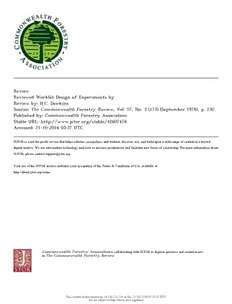
DELETE THIS ITEM PDF
Preview DELETE THIS ITEM
Review Reviewed Work(s): Design of Experiments by Review by: H.C. Dawkins Source: The Commonwealth Forestry Review, Vol. 57, No. 3 (173) (September 1978), p. 230 Published by: Commonwealth Forestry Association Stable URL: http://www.jstor.org/stable/42607478 Accessed: 21-10-2016 05:37 UTC JSTOR is a not-for-profit service that helps scholars, researchers, and students discover, use, and build upon a wide range of content in a trusted digital archive. We use information technology and tools to increase productivity and facilitate new forms of scholarship. For more information about JSTOR, please contact [email protected]. Your use of the JSTOR archive indicates your acceptance of the Terms & Conditions of Use, available at http://about.jstor.org/terms Commonwealth Forestry Association is collaborating with JSTOR to digitize, preserve and extend access to The Commonwealth Forestry Review This content downloaded from 14.139.211.229 on Fri, 21 Oct 2016 05:37:57 UTC All use subject to http://about.jstor.org/terms 230 REVIEWS T. scleroxylon has a wide east-west distribution (3900 km spreading across 13 countries) in West Africa but is generally confined to the narrow band of low-lying humid tropical forest with a few isolated occurrences in drier derived savannah areas. Together with Terminalia superba and Cholorphora excelsa, Triplochiton scleroxylon is described as one of the longer living pioneer species, and a component of a secondary, closed forest community which develops as a result of colonization after clearing for cultivation. Despite an erratic flowering and fruiting habit, the species is abundant over most of its range. It is absent from undisturbed climax forest. From an ecological viewpoint, it would seem that T. scleroxylon has the attributes which are found in many of the more successful plantation species in the tropics and it may only be the difficulty of raising stock on a regular basis which has prevented it from assuming an important role in plantations and enrichment planting schemes. It was logical, therefore, that work in the project centred initially on solving the problems of reproduction and propagation. Rapid progress was made in developing techniques for handling fruit, and seed can now be stored for up to three years. However, inadequate and erratic fruiting still makes it difficult to raise large stocks of seedlings. A major portion of the report is devoted to describing methods of vegetative propagation, particularly by cuttings with which success was so good that costs are comparable with those for seedling production. There is a very rapid fall-off in rooting ability with increasing age but the juvenile condition of the ortet can be maintained by repeated cutting back. Despite its wide and, in parts, discontinuous distribution, little evidence was found of any clinal variation in T. scleroxylon. On the other hand a large amount of tree to tree phenotypic variation in bole and crown morphology has been noted. The progress made on propagation by seed and cuttings, and knowledge gained on flowering behaviour, have permitted the project to embark on a long-term programme of genetic improvement and the study of variation within the species using clonal stock. Extensive experimental plantings (30 ha) have been made in a number of sites in Nigeria using material collected throughout the distribution range in West Africa. These will form an important part of future work to exploit the potential, and also to avoid the dangers, inherent in a system where propagation is by vegetative means. Throughout the report, good clear histograms, graphs and diagrams are used with excellent effect. The photographs on nine plates are well chosen to illustrate important points but their reproduction does not do them credit. There is a comprehensive table of contents which makes it easy to use the report as a reference work and a useful bibliography of over 170 of the more useful references on T. scleroxylon. The authors' intention is that the publication should serve as a working document for further work on this project and particularly as a research model for a similar approach with other species. In my opinion, substantial progress has been made in an important area of tropical forestry and the Forestry Research Institute of Nigeria has achieved impressive results in this cooperative programme with the United Kingdom. R.D. Barnes Design of Experiments. Statistical Checklist No. 1, issued by the Institute of Terrestrial Ecology, is a seven-page folding pamphlet written by John Jeffers, now the Director of that Institute. It lists 71 questions which an experimenter must ask before a field experiment is laid out, with the object of checking that he is not about to do something stupid, unsound, ineffective, wasteful or perhaps merely inefficient. The questions are arranged in nine stages: objectives, defining the population, selecting treatments, plot shape and size, replication, layout, randomization, recording, and analysis. Finally, Question 7 1 - "If you are in doubt about the purpose of any of the questions in this checklist, should you not obtain some advice from a statistician ... ?" Indeed you should! There is a well-chosen bibliography of twelve books, and the pamphlet is available for 30p if a stamped-addressed envelope is sent to Publications Officer, I.T.E., 68 Hills Road, Cambridge. In my view, this pamphlet should most certainly be read by every forest researcher before he sets out his next experiment, and by every authority about to approve - or disapprove - somebody else's experiment. H.C. Dawkins Wildland Fire Management, A Systems Approach, by A.J. Simard. Canadian Forestry Service, Forestry Technical Report 17, 1977. v + 25pp. The application of systems theory is now widespread in many different disciplines. The general theory of systems is a methodology designed to analyse systems exhibiting collective behaviour This content downloaded from 14.139.211.229 on Fri, 21 Oct 2016 05:37:57 UTC All use subject to http://about.jstor.org/terms
